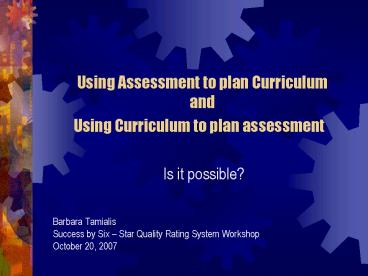Using Assessment to plan Curriculum and Using Curriculum to plan assessment - PowerPoint PPT Presentation
1 / 14
Title:
Using Assessment to plan Curriculum and Using Curriculum to plan assessment
Description:
... of quality preschool curriculum: Should be reflected in our written plan ... Adjusting lesson plans/materials/environment. Considering individual needs ... – PowerPoint PPT presentation
Number of Views:237
Avg rating:3.0/5.0
Title: Using Assessment to plan Curriculum and Using Curriculum to plan assessment
1
Using Assessment to plan CurriculumandUsing
Curriculum to plan assessment
- Is it possible?
- Barbara Tamialis
- Success by Six Star Quality Rating System
Workshop - October 20, 2007
2
A look at the NAEYC Accreditation criteria for
curriculum and assessment
- 2A curriculum essential characteristics
- 4D adapting curriculum, individualizing
teaching and informing program development
3
Curriculum is
- Broader than activities
- A lively, ongoing process
- It is what is happening in the program
- Looks a bit different in each program
- No one right way
4
A written plan that is based on
- Sound child development principles
- Accepted standards
- Best practice
- Documentation of interests and development of the
children for whom it is planned
5
A Road Map that shows
- Starting place where are we now?
- Where you want to go (goals for children's
development and learning) - How to get there (experiences, time, space and
materials needed)
6
Five Key components of quality preschool
curriculum
- Should be reflected in our written plan
7
1. Learning
- Stimulating learning opportunities in a variety
of learning domains (whole child) - Active learning
- Learning goals
8
2. A rich classroom environment
- Room arrangement
- Presentation of materials
- Types of materials present
- Environment directs children to productive use of
materials
9
3. Respectful caring, relationships
- Risk-taking in a safe environment
- Knowing childs family and culture
- Partnership with parents
10
4. Observation and Reflection
- Authentic, intentional observation of the whole
child - Reviewing observation notes
- Adjusting lesson plans/materials/environment
- Considering individual needs
11
5. Adjustments and accommodations(planned and
spontaneous)
- Available materials
- Activity length
- Level of physical involvement
- Amount of teacher directed vs. child choices
- Activity themes/projects
- Goals for individual children
12
Exercise What can I learn from studying
childrens work?
13
(No Transcript)
14
Exercise What can I learn from this activity?































